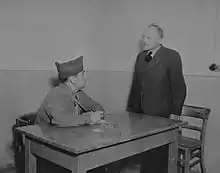
Berga an der Elster was a subcamp of the Buchenwald concentration camp.[1] The Berga forced labour camp was located on the outskirts of the village of Schlieben. Workers were supplied by Buchenwald concentration camp and from a prisoner-of-war camp, Stalag IX-B; the latter contravened the provisions of the Third Geneva Convention and the Hague Treaties. Many prisoners died as a result of malnutrition, sickness (including pulmonary disease due to dust inhalation from tunnelling with explosives), and beatings,[2] including 73 American POWs.[3][4]
The labor camp formed part of Germany's secret plan to use hydrogenation to transform brown coal into usable fuel for tanks, planes, and other military machinery. However, the camp's additional purpose was Vernichtung durch Arbeit ("extermination through labor"), and prisoners were intentionally worked to death under inhumane working and living conditions, suffering from starvation as a result. This secondary purpose of extermination was carried out until the war's end, when the prisoners were subjected to a forced death march in an attempt to keep them ahead of the advancing Allied forces.[4]
POWs were put to work, together with concentration camp inmates, digging 17 tunnels for an underground ammunition factory, some of them 150 feet below ground. As a result of the appalling conditions, malnutrition and cold, as well as beatings, 47 prisoners died.[5] The U.S. military authorities never acknowledged the incident.
On 4 April, the 300 surviving American prisoners were marched out of the camp ahead of approaching U.S. troops. After a 2½-week forced march, they were finally liberated. During this march, another 36 Americans died.[6]
During an air raid, while the camp lights were extinguished, Hans Kasten, Joe Littel and Ernst Sinner escaped. They were later arrested and taken to Gestapo headquarters. After their identities as POWs were confirmed they were taken to the Buchenwald concentration camp and placed in detention cells. They were freed when KZ Buchenwald was liberated.[7]
The commandant of Berga was Willy Hack. However, a sergeant named Erwin Metz was ultimately responsible for the work details and many of the inhumane conditions. He gave the order to take the prisoners on the death march. When the Allied forces closed in on the retreating Germans, Metz deserted his post and attempted to escape by bicycle. He was captured days after the prisoners were liberated by American forces, and sentenced to death for killing a US POW, Pvt Morton Goldstein (Battery C/590th Field Artillery/106 US Division) on March 14, 1945. His sentence was commuted to 20 years' imprisonment but he only served nine years before being released.[4] Hack was arrested in the Soviet occupation zone of Germany in 1947. He was found guilty in 1948 of his complicity in atrocities leading to the deaths of hundreds of people at the Mittelbau-Dora camp and the Berga camp, and sentenced to 8 years in prison. After a retrial, Hack's sentence was increased to death in 1951, and he was executed in Dresden in 1952.[8][9]
References
- ↑ "After 63 years, vet learns of brother's death in Nazi slave camp". CNN. 2008-11-20. Retrieved 2008-11-20.
- ↑ "New photo: Nazis dig up mass grave of U.S. soldiers". CNN. 2009-04-24. Retrieved 2009-04-24.
Berga an der Elster was a slave labor camp where 350 U.S. soldiers were beaten, starved, and forced to work in tunnels for the German government. The soldiers were singled out for "looking like Jews" or "sounding like Jews," or dubbed as undesirables, according to survivors. More than 100 soldiers perished at the camp or on a forced death march.
- ↑ Reich, Walter (2005-05-01). "Yanks in the Holocaust". The New York Times. Retrieved 2010-04-26.
- 1 2 3 Hitler's G.I. Death Camp (television documentary). National Geographic. 2012.
- ↑ Uhl, John (2012). "Berga - Soldiers of Another War: Berga and Beyond". PBS. Archived from the original on 10 January 2012. Retrieved 20 May 2012.
- ↑ Bard, Mitchell G. "Berga am Elster: American POWs at Berga". Jewish Virtual Library. Retrieved December 14, 2019.
- ↑ Kasten, J.C.F. "Hans" (2012). "Personal Narrative: Johann Carl Friedrich Kasten IV". Library of Congress : Veterans History Project. Retrieved 20 May 2012.
- ↑ "Nazi Crimes on Trial". expostfacto.nl. Retrieved 2022-09-27.
- ↑ "Berga-Elster ("Schwalbe V")". encyclopedia.ushmm.org. Retrieved 2023-08-25.